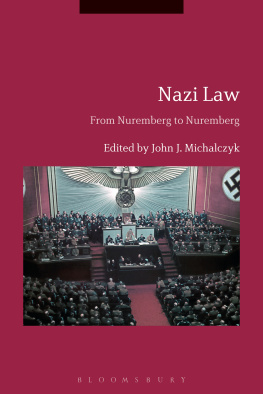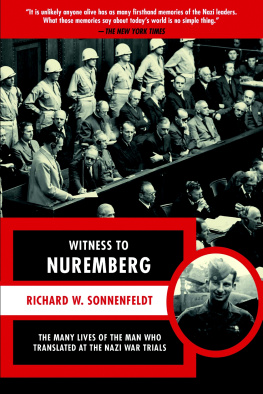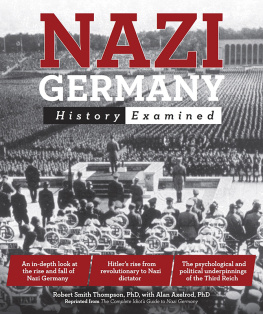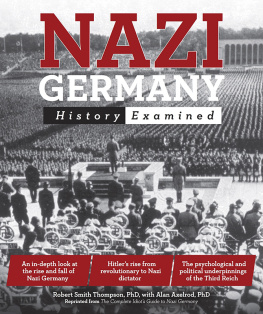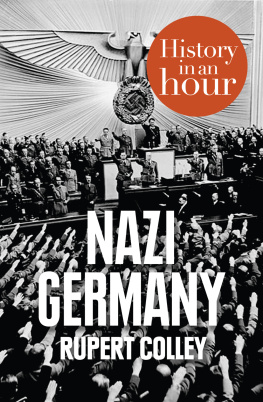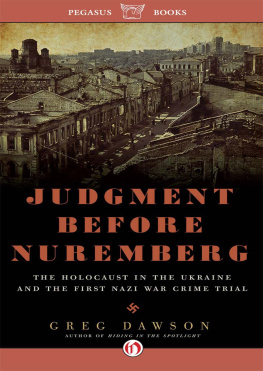Nazi Law
To Susan, a woman of incredible brilliance and integrity, and Raymond G. Helmick, S.J., our mentor.
Nazi Law
From Nuremberg to Nuremberg
Edited by
John J. Michalczyk
Bloomsbury Academic
An imprint of Bloomsbury Publishing Plc

Contents
Carl Schmitt (18881985): German jurist, statesman, and political theorist. Photo by ullstein bild/ullstein bild via Getty Images. |
Eugenics posters entitled The Nuremberg Law for the Protection of Blood and German Honor. Courtesy of the United States Holocaust Memorial Museum. |
An array of posters announcing the arrival of Marshal Ptain to Marseilles. Courtesy of the United States Holocaust Memorial Museum. |
Group portrait of the administrative staff of the Kielce ghetto Judenrat (Jewish Council) in their office. Courtesy of the United States Holocaust Memorial Museum. |
President Roland Freisler of the Peoples Court. Courtesy of the Bundesarchiv. |
Mordechai Chaim Rumkowski, chairman of the Jewish Council, meets with a group of rabbis around a dining hall in the Lodz Ghetto. Courtesy of the United States Holocaust Memorial Museum. |
Magnus Hirschfeld (center) with his coworker Bernhard Schapiro (18851966) and his Chinese friend Tao Lee, sitting at a garden table. Courtesy of the United States Holocaust Memorial Museum. |
View of the defendants in the Nuremberg Doctors Trial with Karl Brandt seated in the first row on the left. Photo by Keystone-France/Gamma-Keystone via Getty Images. |
Oskar Schindler poses with his office employees at the Emalia enamelworks. Courtesy of the United States Holocaust Memorial Museum. |
General Dwight D. Eisenhower, supreme Allied commander, accompanied by General Omar N. Bradley and Lieutenant General George S. Patton, Jr., inspects art treasures stolen by Germans and hidden in salt mine in Germany. Courtesy of the United States Holocaust Memorial Museum. |
A portrait of Pope Pius XI is saved from the destroyed church in besieged war. (Pius XI was pope at the Vatican signing of the 1933 Concordat with Nazi Germany). Courtesy of the United States Holocaust Memorial Museum |
Pastor Martin Niemller poses in a doorway with two other clergymen from the Confessing Church in Berlin during the Third Reich. Courtesy of the United States Holocaust Memorial Museum. |
Headquarters of the War Crimes Group of the Dachau concentration camp. Courtesy of the United States Holocaust Memorial Museum. |
An American soldier guards the main entrance to the courtroom during the I. G. Farben trial. In the back sits the Military Tribunal VI. Courtesy of the United States Holocaust Memorial Museum. |
Defendant Herta Oberhauser is sentenced to twenty years in prison by the Military Tribunal at the Doctors Trial. Courtesy of the United States Holocaust Memorial Museum. |
Leila A. Amineddoleh is an attorney and the founder of Amineddoleh & Associates, LLP where she specializes in art, cultural heritage, and intellectual property law. She represents major art collectors and dealers in matters related to high-profile multimillion dollar contractual disputes, international cultural heritage law violations, the recovery of stolen art, and complex fraud schemes. She has published extensively on issues related to art, cultural heritage, and intellectual property, and has appeared in major news outlets, including the New York Times , Forbes magazine , The Guardian , TIME magazine , and the Wall Street Journal . She also serves as the art law and art crime correspondent for Artsy. As a recognized expert in art, cultural heritage, and intellectual property law, she teaches International Art & Cultural Heritage Law at Fordham University School of Law and St. Johns University School of Law, in addition to Art Crime and the Law at New York University. She was also privileged to serve as the executive director of the Lawyers Committee for Cultural Heritage Preservation for three years.
George J. Annas, JD, MPH is a William Fairfield Warren distinguished professor and the director of the Center for Health Law, Ethics & Human Rights at Boston Universitys School of Public Health, School of Medicine, and School of Law. He is the author or editor of twenty books on health law and human rights, including The Rights of Patients , American Bioethics , Worst Case Bioethics , and The Nazi Doctors and the Nuremberg Code .
Gerhard Besier is a historian (PhD), theologian (DD and Habilitation), and psychologist (Diploma). In 2009, he received an honorary doctorate from the University of Lund, Sweden. He has held chairs in Contemporary (Church) History and European Studies at the Universities of Berlin, Heidelberg, and Dresden, is currently director of the Sigmund Neumann Institute (Berlin-Dresden-Flensburg), and teaches at Stanford University, USA. His book, The Holy See and Hitlers Germany , was published by Palgrave in 2007. In 2013, he published European Dictatorships: A Comparative History of the Twentieth Century (Cambridge Scholars Publishing, CSP, coedited with Katarzyna Stoklosa). In 2014, he published Neither Good Nor Bad: Why Human Beings Behave How they Do (CSP) and the anthology European Border Regions in Comparison: Overcoming Nationalistic Aspects or Re-Nationalization? (Routledge, coedited by Katarzyna Stoklosa). In 2015, he published the correspondence between Bishop George Bell (Chichester) and the general secretary of the World Council of Churches, Willem A. Vissert Hooft, 2 volumes 19381958 (CSP).
Paul Bookbinder is professor of history at the University of Massachusetts, USA, and a historian who teaches and writes about Weimar Germany, Nazi Germany, postSecond World War Germany, the Holocaust, and terrorism. His scholarship has been focused on the work of Carl Schmitt since his Brandeis professor Herbert Marcuse suggested his work as a dissertation topic. Among his publications relevant to Schmitt are Weimar Germany: The Republic of the Reasonable, Carl Schmitt and Der Leviathan, in International Social Science Review, Hermann Heller vs. Carl Schmitt: The Struggle of Parliamentary Democracy vs. Totalitarian Dictatorship during the Weimar Years, in International Social Science Review.
Michael S. Bryant is professor of history and legal studies at Bryant University, USA, where he specializes in the impact of the Holocaust on the law, human rights, German criminal law, and international humanitarian law. Professor Bryant is the author of Confronting the Good Death: Nazi Euthanasia on Trial, 1945-53 and numerous articles on the postwar adjudication of Nazi-era crimes. His study of the major West German Operation Reinhard death camp investigations and trials of the 1960s, Eyewitness to Genocide , was published in 2014 by the University of Tennessee Press, winning the Book of the Year Award from the American National Chapter, Association Internationale de Droit Penal. His third book, A World History of War Crimes : From Antiquity to the Present , was published in November 2015 by Bloomsbury Academic Press in London (UK). Professor Bryant is currently at work on a multiauthor casebook, Global Legal Traditions of the 21st Century (Lexis-Nexis), to which he is contributing chapters on the German legal system and its history.
Sondra Crosby, MD is an internist and former codirector of the Boston Center for Refugee Health and Human Rights at Boston Medical Center, USA. She is an associate professor of medicine and public health at the Boston University School of Medicine. Dr. Crosbys clinical practice focuses on care of asylum seekers, asylees, and refugees, and she has written over 200 affidavits documenting medical and psychological sequelae of torture. She has published scholarly papers in multiple peer-reviewed journals in the field of caring for survivors of torture and recently was awarded the 2008 Leonard Tow Humanism in Medicine Award by the Arnold P. Gold Foundation.

